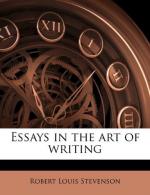Here, then, we have a fresh pattern—a pattern, to speak grossly, of letters—which makes the fourth preoccupation of the prose writer, and the fifth of the versifier. At times it is very delicate and hard to perceive, and then perhaps most excellent and winning (I say perhaps); but at times again the elements of this literal melody stand more boldly forward and usurp the ear. It becomes, therefore, somewhat a matter of conscience to select examples; and as I cannot very well ask the reader to help me, I shall do the next best by giving him the reason or the history of each selection. The two first, one in prose, one in verse, I chose without previous analysis, simply as engaging passages that had long re-echoed in my ear.
’I cannot praise a fugitive and cloistered virtue, unexercised and unbreathed, that never sallies out and sees her adversary, but slinks out of the race where that immortal garland is to be run for, not without dust and heat.’ {4} Down to ‘virtue,’ the current S and R are both announced and repeated unobtrusively, and by way of a grace-note that almost inseparable group PVF is given entire. {5} The next phrase is a period of repose, almost ugly in itself, both S and R still audible, and B given as the last fulfilment of PVF. In the next four phrases, from ‘that never’ down to ’run for,’ the mask is thrown off, and, but for a slight repetition of the F and V, the whole matter turns, almost too obtrusively, on S and R; first S coming to the front, and then R. In the concluding phrase all these favourite letters, and even the flat A, a timid preference for which is just perceptible, are discarded at a blow and in a bundle; and to make the break more obvious, every word ends with a dental, and all but one with T, for which we have been cautiously prepared since the beginning. The singular dignity of the first clause, and this hammer-stroke of the last, go far to make the charm of this exquisite sentence. But it is fair to own that S and R are used a little coarsely.




